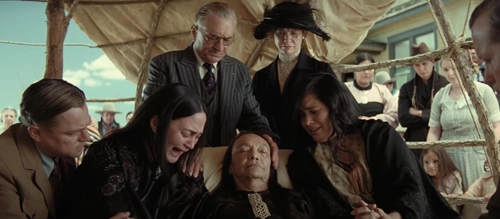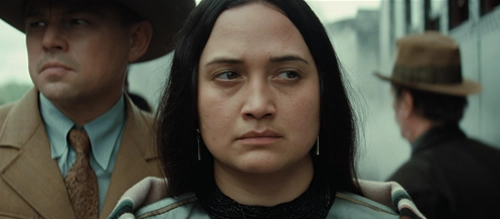Killers of the Flower Moon (2023) Review

Killers of the Flower Moon (2023)
Director: Martin Scorsese
Screenwriters: Eric Roth, Martin Scorsese
Starring: Leonardo DiCaprio, Robert De Niro, Lily Gladstone, Jesse Plemons, Tantoo Cardinal, John Lithgow, Brendan Fraser, Cara Jade Myers, Janae Collins, Jillian Dion
Is there any greater betrayal than the betrayal of someone who loves you? This is the central question at the heart of Martin Scorsese’s newest epic, Killers of the Flower Moon. Starring the renowned director’s long-time and dearly loved collaborators Robert De Niro and Leonardo DiCaprio, alongside Lily Gladstone, Killers of the Flower Moon is an adaptation of David Grann’s explosive book of the same name.
The book, published in 2017, investigates a series of gruesome murders in Osage County, Oklahoma, following the discovery of large oil deposits on Native American land, alongside the birth of the Federal Bureau of Investigation (FBI). Although the book is credited as Scorsese’s source material, Killers of the Flower Moon reads more as a companion piece to Grann’s novel, with Scorsese finding a unique perspective from which to access this insidious tale.
Scorsese’s three-and-a-half-hour-long true-crime epic finds its footing within the love story between Ernest and Mollie Burkhart. Ernest, played by Leonardo DiCaprio, is a newcomer to the small but affluent Osage County. Upon arrival, and with much encouragement from his persistent uncle, William Hale (Robert De Niro), a man who insists that his friends and family call him King, Ernest meets Mollie (Lily Gladstone, Certain Women). Mollie, an Osage-born native, like several members of her tribe, is a multimillionaire, owing to the plentiful amounts of black gold found upon her family’s land. In antithesis to the barren western town upon which our stage is set, First Nation people ride around in chauffeur-driven cars and wear expensive furs. They appear as the image of wealth and prosperity, although access to their money must be first justified and requested through their white trustees.
Ernest, fresh from the war, is upfront about his desire for wealth: ‘I just love money’ he declares playfully throughout the film, slowly revealing himself as a man willing to scheme and bend the law to get the cash to flow in his direction. William Hale, a wealthy cattle farmer in his own right, is consumed by a desire for the oil deposit ‘headrights’ on Mollie’s land, the pursuit of which he considers fair game. The only thing standing in his way is Mollie and her family. Hale, well versed in the legal benefits of marriage, encourages his family to pursue the young and stupidly rich Osage women so they might reap the benefits of inheritance should any unfortunate event befall them. One by one, Mollie’s family starts to dwindle: unexplainable illness, murder, and unprecedented explosions begin to plague the family until all of the headrights conveniently rest with Mollie and her husband Ernest.
Leonardo Dicaprio, who ran from the set of Titanic directly into Martin Scorsese’s arms, gives one of the best performances of his career as Ernest. The melancholy downward turn of his mouth and slow southern drawl indicate a simpleton, incapable of fully understanding the atrocity of William Hale’s plot against his wife and her family. DiCaprio presents us with the enigma of a man consumed with love for a woman he is actively trying to murder. Across from him is Lily Gladstone, who plays Mollie with a steadfast sensibility and awareness of the men around her. She has Earnest and his family pegged from day one, her wry smile and persistent calmness indicating that she is always one step ahead of any danger that might present itself. Yet love, which has the power to hoodwink even the sharpest of minds, gets in her way.

As the murders progress, so does Molly and Ernest’s relationship. In between harrowing scenes of grief and murder, we see them cling to each other desperately for comfort. He takes her into his arms while she struggles with the agony of her grief. He learns her language and traditions, and they parent three children, who they protect and adore fiercely. With each fresh death, Mollie’s circle grows smaller, and Ernest becomes the last man she can trust. How couldn’t she? We watch as he begs and pleads with her to take a life-saving new drug (insulin) that will regulate her diabetes, as if he isn’t the one also spiking the medication with a poison that will slowly kill her. ‘I love this woman’ he tells his uncle sincerely, as Hale explains the uncanny way Osage women never manage to live to a ripe old age.
As Hale, Robert De Niro circles like a vulture, conjuring the same chilling presence he portrayed as Max Cady in Scorsese’s remake of the revenge classic Cape Fear. The potency of his performance bleeds out of the screen, filling all empty space with a feeling of looming threat. Hale has seeded himself deeply into the Osage community as a friend and ally, offering up reward money to anyone who might have information about the suspicious deaths creeping up all around them. Like Jack Nicholson’s Costello in The Departed, Hale is above the law, and he’s become cocky and psychopathically devoid of loyalty and love.
Killers of the Flower Moon is nothing short of a masterpiece from our greatest living filmmaker. Although the film’s stealthy runtime might feel harsh on our bladders, the film is extremely well-placed; the story blooms organically and doesn’t waste a single second. Scorsese’s mastery of filmmaking is apparent in every single frame; he understands exactly where the camera needs to be, and it dances beautifully within the story, offering us an immensely satisfying masterclass in storytelling. This is the first time Scorsese’s two best boys have shared the screen in a Martin Scorsese picture, and the result is electric. The film feels like an extension of their friendship and shared legacy. There is a collective sense that the three men are comfortable enough with one another to experiment and take chances with our expectations. Gladstone, alongside an impossibly talented supporting cast, keep the boys on their toes, taking the iconic trio to unseen heights.
The film’s greatest strength is the unique vantage point from which it approaches the atrocities. Although the crimes depicted on screen happened many years ago, the treatment of the First Nation people throughout America’s vast history is still an open wound. Scorsese, like Grann, approaches his work with the utmost respect and care. To escape the connotations of Westerns and crime dramas, which typically circle the white-lead adventures of cowboys and lawmen, Scorsese dives right into the heart of the truth, presenting Killers of the Flower Moon as a love story. While the great filmmaker still utilises the atmospheric soul of the Wild West, by presenting a more human perspective, he cuts right to the centre of the raw open heart of a woman in love, and we feel the sting of betrayal tenfold.
Score: 24/24
Recommended for you: Where to Start with Martin Scorsese

